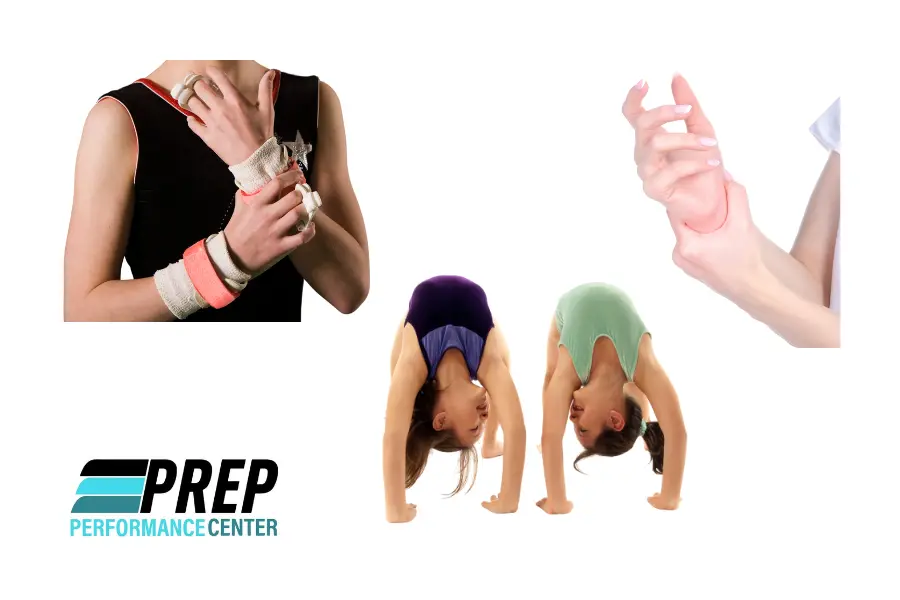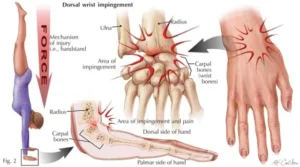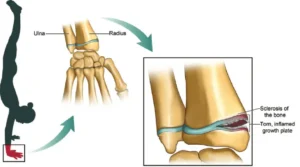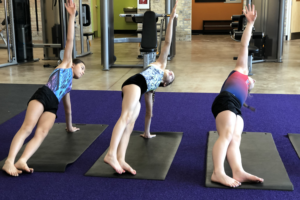Gymnastics is an extremely intense sport both emotionally and physically. The physical demands of this sport unfortunately leave gymnasts susceptible to almost any injury under the sun. Wrist pain is very commonly experienced by gymnasts, males, and females alike. Distal Radial Epiphysitis, also called “Gymnast Wrist”, specifically, is a common diagnosis that may explain this wrist pain amongst gymnasts due to the sport’s repetitive nature.
Upper body injuries are more common in male and female gymnasts compared to other sports. The upper extremities are weight-bearing joints and absorb direct forces in all events of both men’s and women’s gymnastics. Acute injuries, such as a wrist fracture, often occur from a fall on an outstretched arm. However, injuries related to overuse and overtraining, such as Distal Radial Epiphysitis, are more common in gymnasts.
The Diagnosis and How This Occurs:
– Distal Radial Epiphysitis, also known as “Gymnast Wrist”, is a growth plate injury to an adolescent gymnast with immature, growing bone structures
– The growth plate is prone to injury because the ligaments and joint capsule of the wrist are stronger than the cartilaginous growth plate
– Repeated loading and wrist hyperextension cause the body’s forces to be directed to the radius bone which has not yet fused. This causes inflammation and widening of the growth plate. This often occurs with dorsal wrist impingement.
Common Symptoms:
– Several weeks of unilateral or bilateral wrist pain
– Usually occurs gradually, without history of acute trauma
– Worsened pain with load bearing activities and when the wrist is extended
– Pain relieved with rest
– Range of motion normal or slightly limited due to pain
– Possible decrease in grip strength
– Tender to palpation along the distal radius
– Swelling may be present
Differential Diagnoses:
– Dorsal Wrist Impingement
– Scaphoid Stress Fracture
– Carpal Ligament Sprains (Scapholunate and Lunotriquetral Ligament Injuries)
– Triangular Fibrocartilage Complex Injuries
– Ulnar Impaction
– De Quervain’s Tenosynovitis
– Distal ulnar or radial stress fracture
Pertinent Tests/Diagnostic Imaging:
– X-ray findings will typically appear normal
– In severe cases, a widening of the growth plate or ulnar variance may be visible
– X-rays may be recommended 6-12 weeks post diagnosis or when symptoms subside to verify proper healing, but are usually not necessary if the initial X- rays appeared normal
– Routine X-rays may be recommended for about 6 months to one year post injury if the initial X-ray showed a lot of damage to the growth plate
– MRI is not usually necessary
Risk Factors:
– Repetitive stress predisposes the wrist to acute injury, overuse injuries, and degenerative damage
– Adolescent athlete with premature growth plates
– Adolescent gymnasts ages 10-14 are more likely to have wrist pain
– Recent growth spurt causing transient weakness at the growth plate
When to Seek Medical Attention:
– Persistent pain that does not improve with rest over time
– If this condition progresses it could lead to a fracture of the growth plate or ulnar variance
– Ulnar Variance: if Gymnast Wrist becomes chronic and goes untreated, the growth plate may close prematurely resulting in cessation of radial growth too early, while the ulna continues to grow
– Positive Ulnar Variance (the ulna appears longer): may result in altered wrist biomechanics, decreased wrist range of motion, and altered loading in weight bearing positions of the wrist
– Progressive damage to the ulnar side of the wrist may increase risk for chronic wrist pain and dysfunction
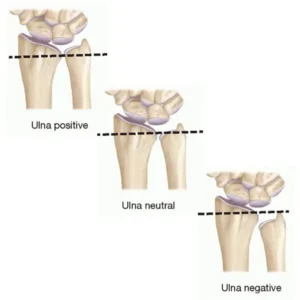
Principles and Goals of Wrist Pain Treatment:
– Decrease the stress that is causing the pain
– Stop weight bearing exercises for about 6 weeks or until symptoms subside
– Wrist rehab to achieve symmetrical wrist range of motion and strength
– Improve shoulder flexibility and thoracic spine mobility
– Alternative training and conditioning aimed at improving upper body and core strength to decrease the stress on the wrist joint when returning to gymnastics
– Stage 1: correct impairments in joint mobility, muscle length, and neuromuscular control in the spine, shoulder, and upper extremity joints
– Stage 2: continue manual techniques to correct impairments, progress exercises in neuromuscular control, introduce sport specific activities in limited weight bearing positions
– Stage 3: address impairments with manual techniques as needed, advance exercises in neuromuscular control, progress sport specific activities to full weight bearing positions
Return to Sport:
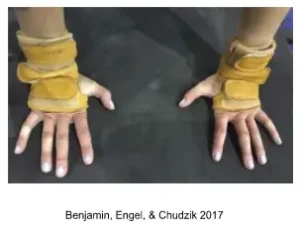
– Once there is a decrease in pain, and range of motion and strength have been restored, the gymnast can begin a gradual increase in training load
– It is important that there is careful attention to sport biomechanics and proper form/ technique to limit further damage or re-injury
– Wrist braces may also be worn to limit excessive wrist hyperextension
Exercises to try if you may have Wrist Pain in Gymnast:
Wrist specific exercises
– Hand arch and splay
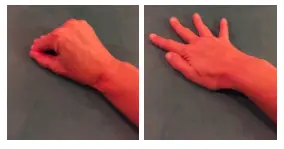
– 4-way wrist strengthening (flexion, extension, ulnar and radial deviation)

